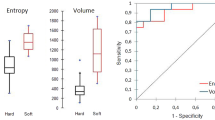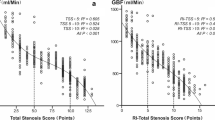Abstract
Carotid plaque is one of the predominant causes of stroke. We sought to build a nomogram using ultrasonography (US)-based radiomics and clinical features for identification of symptomatic carotid plaques. We prospectively enrolled 548 patients (mean age ± standard deviation, 63 ± 10 years; 373 men) were randomly divided into training and test cohorts. Clinical and conventional US features of carotid plaques were used to generate a clinical and conventional US model. US-based radiomics model was constructed by extracting radiomics features from grayscale and strain elasticity images. Multivariate logistic regression was performed using the radiomics scores together with clinical and conventional US data, and a final nomogram was subsequently developed. The performance of the final nomogram was assessed with respect to discrimination and clinical usefulness in the training of the test cohorts and contrast-enhanced US test cohort. All the radiomics scores were significantly higher in patients with symptomatic carotid plaques. The US-based radiomics model [area under the curve (AUC) = 0.930 and 0.922 for training and test cohorts, respectively] and final nomogram (AUC = 0.927 and 0.919, respectively) outperformed the clinical and conventional US model (AUC = 0.723 and 0.580, respectively). The decision curve analysis indicated that the final nomogram was clinically useful. In patients undergoing the contrast-enhanced US, the prevalence of plaque enhancement was higher in high-risk patients than in low-risk patients based on the final nomogram-score (P = 0.008). Nomogram has a high diagnostic performance for identification of symptomatic carotid plaques.



Similar content being viewed by others
Abbreviations
- US:
-
Ultrasonography
- SE:
-
Strain elastography
- ROC:
-
Receiver operating characteristic
- AUC:
-
Area under the curve
- ICC:
-
Interclass correlation coefficients
- LASSO:
-
Least absolute shrinkage and selection operator
References
Brinjikji W, Rabinstein AA, Lanzino G, Murad MH, Williamson EE, DeMarco JK, Huston JR. Ultrasound characteristics of symptomatic carotid plaques: a systematic review and meta-analysis. Cerebrovasc Dis. 2015;40:165–74. https://doi.org/10.1161/str.46.suppl_1.tp180.
Irie Y, Katakami N, Kaneto H, Takahara M, Nishio M, Kasami R, Sakamoto K, Umayahara Y, Sumitsuji S, Ueda Y, Kosugi K, Shimomura I. The utility of ultrasonic tissue characterization of carotid plaque in the prediction of cardiovascular events in diabetic patients. Atherosclerosis. 2013;230:399–405. https://doi.org/10.1016/j.atherosclerosis.2013.08.015.
Ruiz-Ares G, Fuentes B, Martínez-Sánchez P, Martínez-Martínez M, Díez-Tejedor E. Utility of the assessment of echogenicity in the identification of symptomatic carotid artery atheroma plaques in ischemic stroke patients. Cerebrovasc Dis. 2011;32:535–41. https://doi.org/10.1159/000330654.
Millon A, Mathevet JL, Boussel L, Faries PL, Fayad ZA, Douek PC, Feugier P. High-resolution magnetic resonance imaging of carotid atherosclerosis identifies vulnerable carotid plaques. J Vasc Surg. 2013;57:1046–51. https://doi.org/10.1016/j.jvs.2012.10.088.
Grimm JM, Schindler A, Freilinger T, Cyran CC, Bamberg F, Yuan C, Reiser MF, Dichgans M, Freilinger C, Nikolaou K, Saam T. Comparison of symptomatic and asymptomatic atherosclerotic carotid plaques using parallel imaging and 3 T black-blood in vivo CMR. J Cardiovasc Magn Reson. 2013;15:44. https://doi.org/10.1186/1532-429X-15-44.
Yamada K, Kawasaki M, Yoshimura S, Shirakawa M, Uchida K, Shindo S, Nishida S, Iwamoto Y, Nakahara S, Sato Y. High-intensity signal in carotid plaque on routine 3D-TOF-MRA is a risk factor of ischemic stroke. Cerebrovasc Dis. 2016;41:13–8. https://doi.org/10.1159/000441094.
Redgrave JN, Lovett JK, Gallagher PJ, Rothwell PM. Histological assessment of 526 symptomatic carotid plaques in relation to the nature and timing of ischemic symptoms: the Oxford plaque study. Circulation. 2006;113:2320–8. https://doi.org/10.1161/CIRCULATIONAHA.105.589044.
Naghavi M, Libby P, Falk E, Casscells SW, Litovsky S, Rumberger J, Badimon JJ, Stefanadis C, Moreno P, Pasterkamp G, Fayad Z, Stone PH, Waxman S, Raggi P, Madjid M, Zarrabi A, Burke A, Yuan C, Fitzgerald PJ, Siscovick DS, de Korte CL, Aikawa M, Juhani AK, Assmann G, Becker CR, Chesebro JH, Farb A, Galis ZS, Jackson C, Jang IK, Koenig W, Lodder RA, March K, Demirovic J, Navab M, Priori SG, Rekhter MD, Bahr R, Grundy SM, Mehran R, Colombo A, Boerwinkle E, Ballantyne C, Insull WJ, Schwartz RS, Vogel R, Serruys PW, Hansson GK, Faxon DP, Kaul S, Drexler H, Greenland P, Muller JE, Virmani R, Ridker PM, Zipes DP, Shah PK, Willerson JT. From vulnerable plaque to vulnerable patient: a call for new definitions and risk assessment strategies: part I. Circulation. 2003;108:1664–72. https://doi.org/10.1161/01.CIR.0000087480.94275.97.
Aboyans V, Ricco JB, Bartelink M, Björck M, Brodmann M, Cohnert T, Collet JP, Czerny M, De Carlo M, Debus S, Espinola-Klein C, Kahan T, Kownator S, Mazzolai L, Naylor AR, Roffi M, Röther J, Sprynger M, Tendera M, Tepe G, Venermo M, Vlachopoulos C, Desormais I. 2017 ESC Guidelines on the diagnosis and treatment of peripheral arterial diseases, in collaboration with the European Society for Vascular Surgery (ESVS): document covering atherosclerotic disease of extracranial carotid and vertebral, mesenteric, renal, upper and lower extremity arteries endorsed by: the European Stroke Organization (ESO) The Task force for the diagnosis and treatment of peripheral arterial diseases of the European Society of Cardiology (ESC) and of the European Society for Vascular Surgery (ESVS). Eur Heart J. 2018;39:763–816. https://doi.org/10.1093/eurheartj/ehx095.
Zhao X, Hippe DS, Li R, Canton GM, Sui B, Song Y, Li F, Xue Y, Sun J, Yamada K, Hatsukami TS, Xu D, Wang M and Yuan C. Prevalence and characteristics of carotid artery high-risk atherosclerotic plaques in Chinese patients with cerebrovascular symptoms: a Chinese atherosclerosis risk evaluation II Study. J Am Heart Assoc. 2017; 6:. https://doi.org/10.1161/JAHA.117.005831
Barnett HJ, Taylor DW, Eliasziw M, Fox AJ, Ferguson GG, Haynes RB, Rankin RN, Clagett GP, Hachinski VC, Sackett DL, Thorpe KE, Meldrum HE, Spence JD. Benefit of carotid endarterectomy in patients with symptomatic moderate or severe stenosis North American Symptomatic Carotid Endarterectomy. Trial Collaborators. N Engl J Med. 1998;339:1415–25. https://doi.org/10.1056/NEJM199811123392002.
Gray-Weale AC, Graham JC, Burnett JR, Byrne K, Lusby RJ. Carotid artery atheroma: comparison of preoperative B-mode ultrasound appearance with carotid endarterectomy specimen pathology. J Cardiovasc Surg (Torino). 1988;29:676–81.
Huang X, Zhang Y, Qian M, Meng L, Xiao Y, Niu L, Zheng R, Zheng H. Classification of carotid plaque echogenicity by combining texture features and morphologic characteristics. J Ultrasound Med. 2016;35:2253–61. https://doi.org/10.7863/ultra.15.09002.
Doonan RJ, Dawson AJ, Kyriacou E, Nicolaides AN, Corriveau MM, Steinmetz OK, Mackenzie KS, Obrand DI, Daskalopoulos ME, Daskalopoulou SS. Association of ultrasonic texture and echodensity features between sides in patients with bilateral carotid atherosclerosis. Eur J Vasc Endovasc Surg. 2013;46:299–305. https://doi.org/10.1016/j.ejvs.2013.05.024.
Kakkos SK, Stevens JM, Nicolaides AN, Kyriacou E, Pattichis CS, Geroulakos G, Thomas D. Texture analysis of ultrasonic images of symptomatic carotid plaques can identify those plaques associated with ipsilateral embolic brain infarction. Eur J Vasc Endovasc Surg. 2007;33:422–9. https://doi.org/10.1016/j.ejvs.2006.10.018.
Bansal S, Gui J, Merrill C, Wong JK, Wilson SR. Contrast-enhanced US in local ablative therapy and secondary surveillance for hepatocellular carcinoma. Radiographics. 2019;39: 180205. https://doi.org/10.1148/rg.2019180205.
Takaya N, Yuan C, Chu B, Saam T, Underhill H, Cai J, Tran N, Polissar NL, Isaac C, Ferguson MS, Garden GA, Cramer SC, Maravilla KR, Hashimoto B, Hatsukami TS. Association between carotid plaque characteristics and subsequent ischemic cerebrovascular events: a prospective assessment with MRI–initial results. Stroke. 2006;37:818–23. https://doi.org/10.1016/j.jvs.2006.04.013.
Zhang R, Zhang Q, Ji A, Lv P, Zhang J, Fu C, Lin J. Identification of high-risk carotid plaque with MRI-based radiomics and machine learning. Eur Radiol. 2021;31(5):3116–26. https://doi.org/10.1007/s00330-020-07361-z.
Hu HT, Wang Z, Huang XW, Chen SL, Zheng X, Ruan SM, Xie XY, Lu MD, Yu J, Tian J, Liang P, Wang W, Kuang M. Ultrasound-based radiomics score: a potential biomarker for the prediction of microvascular invasion in hepatocellular carcinoma. Eur Radiol. 2019;29:2890–901. https://doi.org/10.1007/s00330-018-5797-0.
Park VY, Han K, Lee E, Kim EK, Moon HJ, Yoon JH, Kwak JY. Association between radiomics signature and disease-free survival in conventional papillary thyroid carcinoma. Sci Rep. 2019;9:4501. https://doi.org/10.1038/s41598-018-37748-4.
Jiang M, Li C, Tang S, Lv W, Yi A, Wang B, Yu S, Cui X, Dietrich CF. Nomogram based on shear-wave elastography radiomics can improve preoperative cervical lymph node staging for papillary thyroid carcinoma. Thyroid. 2020;30:885–97. https://doi.org/10.1089/thy.2019.0780.
Touboul PJ, Hennerici MG, Meairs S, Adams H, Amarenco P, Bornstein N, Csiba L, Desvarieux M, Ebrahim S, Fatar M, Hernandez HR, Jaff M, Kownator S, Prati P, Rundek T, Sitzer M, Schminke U, Tardif JC, Taylor A, Vicaut E, Woo KS, Zannad F and Zureik M. Mannheim carotid intima-media thickness consensus (2004–2006). An update on behalf of the advisory board of the 3rd and 4th watching the risk symposium, 13th and 15th European Stroke Conferences, Mannheim, Germany, 2004, and Brussels, Belgium, 2006. Cerebrovasc Dis. 2007; 23:75–80. https://doi.org/10.1159/000097034
Adams HJ, Bendixen BH, Kappelle LJ, Biller J, Love BB, Gordon DL, Marsh ER. Classification of subtype of acute ischemic stroke Definitions for use in a multicenter clinical trial. TOAST. Trial of Org 10172 in Acute Stroke Treatment. Stroke. 1993;24:35–41. https://doi.org/10.1161/01.str.24.1.35.
Gillies RJ, Kinahan PE, Hricak H. Radiomics: images are more than pictures, they are data. Radiology. 2016;278:563–77. https://doi.org/10.1148/radiol.2015151169.
Azizyan A, Sanossian N, Mogensen MA, Liebeskind DS. Fluid-attenuated inversion recovery vascular hyperintensities: an important imaging marker for cerebrovascular disease. AJNR Am J Neuroradiol. 2011;32:1771–5. https://doi.org/10.3174/ajnr.A2265.
Xiong L, Deng YB, Zhu Y, Liu YN, Bi XJ. Correlation of carotid plaque neovascularization detected by using contrast-enhanced US with clinical symptoms. Radiology. 2009;251:583–9. https://doi.org/10.1148/radiol.2512081829.
Jiang B, He D, Zhang L, Ye M. Risk prediction of cerebrovascular events with carotid plaque magneitc resonance analysis: a meta-analysis. J Neuroradiol. 2019;46:117–23. https://doi.org/10.1016/j.neurad.2018.05.003.
Mitchell CC, Stein JH, Cook TD, Salamat S, Wang X, Varghese T, Jackson DC, Sandoval GC, Wilbrand SM, Dempsey RJ. Histopathologic validation of grayscale carotid plaque characteristics related to plaque vulnerability. Ultrasound Med Biol. 2017;43:129–37. https://doi.org/10.1016/j.ultrasmedbio.2016.08.011.
Khan AA, Hecker JC, Lal BK, Sikdar S. Clinical viability of carotid plaque strain estimation using B-mode ultrasound image sequences. Annu Int Conf IEEE Eng Med Biol Soc. 2016;2016:2877–80. https://doi.org/10.1109/EMBC.2016.7591330.
Zhu Y, Deng YB, Liu YN, Bi XJ, Sun J, Tang QY, Deng Q. Use of carotid plaque neovascularization at contrast-enhanced US to predict coronary events in patients with coronary artery disease. Radiology. 2013;268:54–60. https://doi.org/10.1148/radiol.13122112.
Funding
This study was funded by Science, Technology and Innovation Seed Fund from Zhongnan Hospital of Wuhan University (znpy2019089), Wuhan, China.
Author information
Authors and Affiliations
Corresponding authors
Ethics declarations
Ethics Approval
All procedures performed in this study were in accordance with the ethical standards of the Institutional Review Board of Tongji Hospital, Tongji Medical College, Huazhong University of Science and Technology and with the 1964 Helsinki Declaration and its later amendments or comparable ethical standards.
Consent to Participate
Informed consent was obtained from all individual participants included in the study.
Conflicts of Interest
None.
Additional information
Publisher's Note
Springer Nature remains neutral with regard to jurisdictional claims in published maps and institutional affiliations.
Supplementary Information
Below is the link to the electronic supplementary material.
Rights and permissions
About this article
Cite this article
Huang, Z., Cheng, XQ., Liu, HY. et al. Relation of Carotid Plaque Features Detected with Ultrasonography-Based Radiomics to Clinical Symptoms. Transl. Stroke Res. 13, 970–982 (2022). https://doi.org/10.1007/s12975-021-00963-9
Received:
Revised:
Accepted:
Published:
Issue Date:
DOI: https://doi.org/10.1007/s12975-021-00963-9




